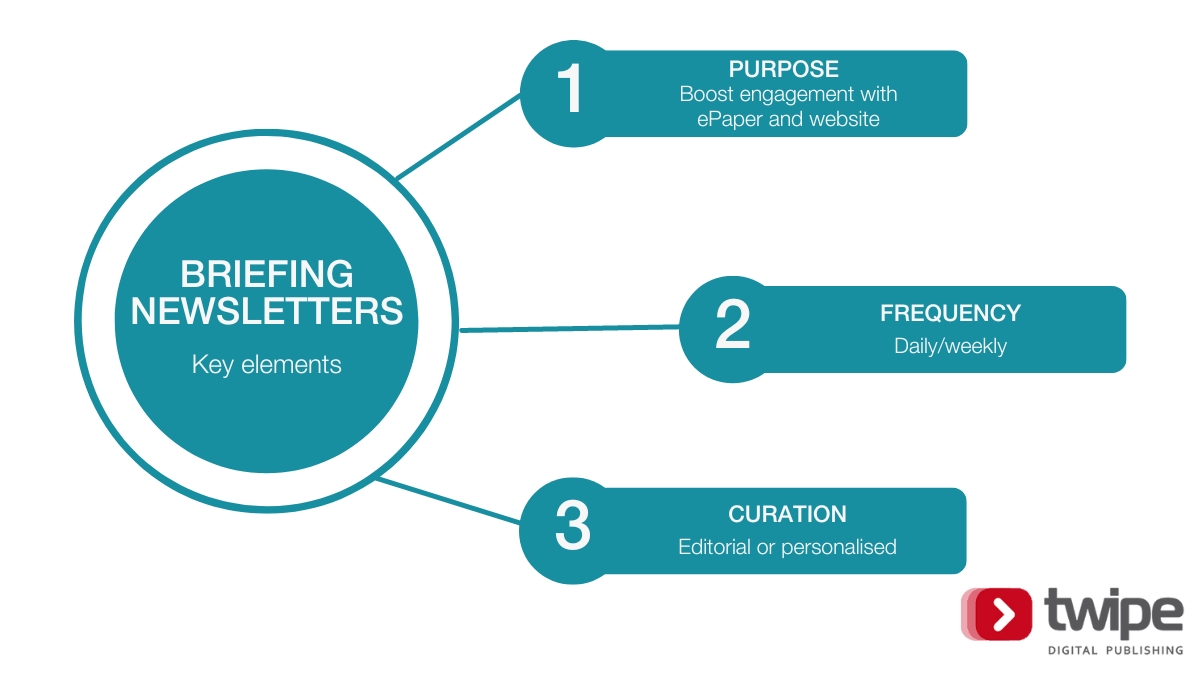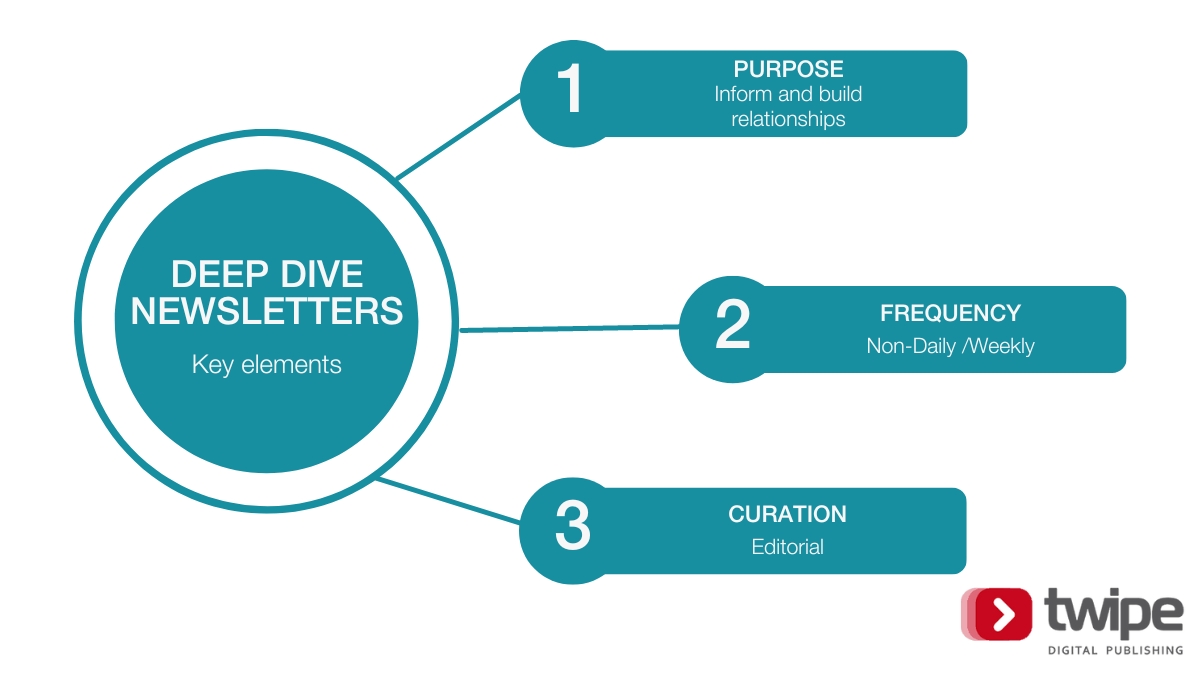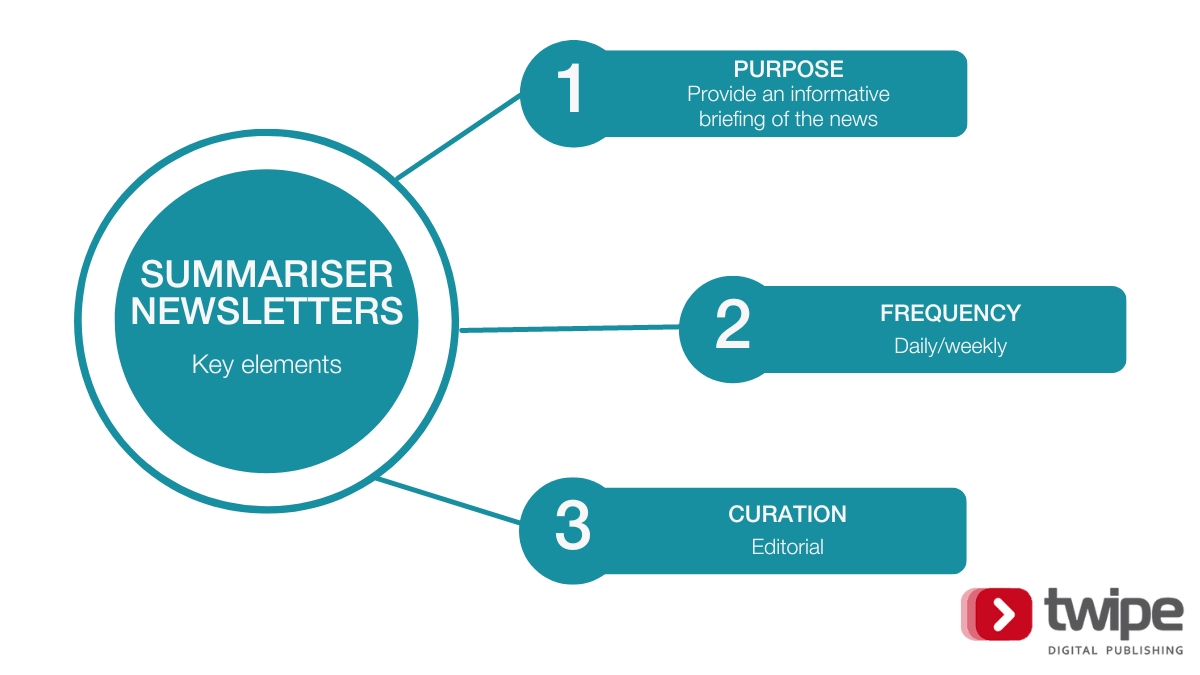3 types of newsletters every publisher should experiment with | What’s New in Publishing

69% of publishers identify newsletters as an area where they will be putting more resources in 2023. According to WAN-IFRA, 50% of publishers already offer between 1-5 newsletters, with the other 50% offering significant amounts more.
Many reasons have been attributed to the success of newsletters in recent years such as harvesting user data and adding value to subscriber bundles. We dive into 3 different newsletter formats you need to know about for your 2023 newsletter strategy.
Type 1: Briefings boosting engagement
Briefing newsletters push subscriber engagement. These tend to be dailies and are a window to the day’s news, exposing readers to the main stories of the day. Briefings tend to come in 2 forms: ePaper announcements and Daily Briefings.
ePaper announcements are triggers to get subscribers to engage with the day’s ePaper. They act as a partner in life for subscribers and guide them through the must-read stories. The Daily Mail’s ePaper newsletter arrives each morning at 7am and is an important trigger for their Mail+ app. Many other publishers use this ePaper push strategy like Atlanta Journal-Constitution and The Wall Street Journal.
Daily briefings push subscribers to engage with other stories on news websites. They drive clicks and encourage article sharing, exposing readers to stories which may have missed the days edition or broken throughout the day. Danish publisher Børsen have an 11am update to inform their subscribers about the latest financial news ahead of lunch. They also publish Børsen Pro International, a newsletter published in English designed to boost their brand beyond Denmark featuring the latest international news.
Curation of briefings can be done in 2 ways: editorially or through personalisation. Editorial curation provides a generic story selection for all newsletter subscribers. Whilst this gives full control to the newsroom, it can limit the exposure of the full range of stories to readers. News recommender personalisation tools, like JAMES, curate content on a 1 to 1 basis, giving each reader a tailored set of stories. JAMES uses a hybrid algorithm so that subscribers are exposed to a mixture of trending stories to get their need-to-know news, but also stories tailored to their previous reading behaviour. Readers are therefore exposed to 80-90% of the day’s content, showcasing more of the newsroom’s work.
Automation is a tool which can be leveraged by both personalised and editorially curated briefing newsletters. Automation saves newsrooms time focusing on the development of their digest newsletters and allowing them to focus upon their content. In Finland, JAMES automation is central for Mediatalo Keskisuomalainen’s newsletter strategy. As a regional publisher, some of their newsrooms feature as few as 2 members of staff meaning that automation is crucial for their newsletter strategy.

Type 2: Deep dives building relationships
Deep dive newsletters provide detailed content and opinion. They traditionally came in formats like “Letter from the Editor”, however with the late 2010’s growth of platforms like Substack many journalists decided to develop their own long-read newsletters. These newsletters have a personal tone and focus on niche topics or news areas. This helps them build reader relationships and inform readers.
Deep dive newsletters tend to be less frequent than digests as they are editorially written and curated (for now) which is more time consuming. It also means that they require more effort to read from subscribers. Inside these newsletters, expect hot takes and opinion aplenty. These newsletters tend to feature an element of free to subscribe with subscriber-only benefits like extra editions or exclusive content and access.

The Oregonian’s “Letter from Editor” newsletter adds a human face to their reporting through its personal tone. The newsletter often addresses comments from readers and dives into answers so that readers feel heard. “Letter from Editor” also features contact details to promote transparency and openness with their readers.
In the UK, sports gossip newsletter and personal favourite The Upshot is published 3 times a week. Their Friday newsletter is free and dives into sports stories the mainstream media dare not touch. With an Upshot Gold subscription, subscribers get exclusive access to a Sunday edition “Old Gold” reflecting on a retro sports story, and a Wednesday edition diving into exclusive gold stories.

Type 3: Summarisers giving quick hits of the top stories
Summarisers, much like briefings, give a snapshot of the day or week’s top stories. What differentiates the two however is the depth offered. Summarisers provide a briefing on the day’s top stories so that newsletter subscribers don’t have to click through to the full story. They aim to save the subscriber time. With the summary needing to be provided, these newsletters tend to be editorially curated. Summarisers are often daily or weekly newsletters, and some publishers leverage them as a chance to update readers of new stories which may have broken or developed throughout the day.
The Athletic have a “Daily Football Briefing” newsletter giving subscribers summaries of the top stories of the day. Each summary then features a link below to the full article to read more on the app.

Perhaps the most powerful example of a summariser newsletter comes from smart-brevity focused Axios. Their Media Trends newsletter from Sara Fischer gives the lowdown from the biggest media stories in the day. Each story is broken down into small smart chunks to provide subscribers with the need-to-know details from each story. Readers are then free to go and conduct their own research to get more in-depth information on each story.

Social media appearing as a new platform for newsletters
Despite Twitter shutting down Revue and Facebook ending Bulletin, social media platforms are still relying on the potential of newsletters and provide an alternative to email. LinkedIn newsletters have proved a hub for innovation and experimentation. Any type of newsletter can be set up on LinkedIn and they are sent directly to the notifications and email inbox of newsletter subscribers. It is also easy to invite connections to subscribe, much like inviting them to follow a LinkedIn page. Publishers like Forbes, The Financial Times and L’Opinion have already leveraged LinkedIn newsletters. We recently launched our Twipe Weekly News Digest as a LinkedIn newsletter to give our subscribers access to our top 5 stories of the week, with you every Monday morning.
WhatsApp newsletters have also come to the fore. Publishers have previously experimented with WhatsApp but newsletters are a new way to do this. WhatsApp newsletters utilise the broadcast feature and are a more informal way of starting a newsletter. Signing up requires just 2 clicks and no email address. Their frequency is up to the creator, being able to post as frequently or rarely as they want. The fact that these are on an app means that they are already mobile optimised and can easily feature non-text elements like videos and files. The newsletters are easily shareable via links and can be linked directly to a WhatsApp group. Communities can also be built with the most engaged members of newsletters able to be added into private group chats.
Cathy Hackl has a successful Metaverse & Web3 newsletter running whilst Matt Navarra’s Geekout newsletter now also has a home on WhatsApp with over 3600 participants.
Matthew Lynes
Media Innovation Analyst @ Twipe
Get Twipe’s weekly insights on digital publishing, artificial intelligence, and paid content in your mailbox. Sign up here.
Facebook Faces Yet Another Outage: Platform Encounters Technical Issues Again

Uppdated: It seems that today’s issues with Facebook haven’t affected as many users as the last time. A smaller group of people appears to be impacted this time around, which is a relief compared to the larger incident before. Nevertheless, it’s still frustrating for those affected, and hopefully, the issues will be resolved soon by the Facebook team.
Facebook had another problem today (March 20, 2024). According to Downdetector, a website that shows when other websites are not working, many people had trouble using Facebook.
This isn’t the first time Facebook has had issues. Just a little while ago, there was another problem that stopped people from using the site. Today, when people tried to use Facebook, it didn’t work like it should. People couldn’t see their friends’ posts, and sometimes the website wouldn’t even load.
Downdetector, which watches out for problems on websites, showed that lots of people were having trouble with Facebook. People from all over the world said they couldn’t use the site, and they were not happy about it.
When websites like Facebook have problems, it affects a lot of people. It’s not just about not being able to see posts or chat with friends. It can also impact businesses that use Facebook to reach customers.
Since Facebook owns Messenger and Instagram, the problems with Facebook also meant that people had trouble using these apps. It made the situation even more frustrating for many users, who rely on these apps to stay connected with others.
During this recent problem, one thing is obvious: the internet is always changing, and even big websites like Facebook can have problems. While people wait for Facebook to fix the issue, it shows us how easily things online can go wrong. It’s a good reminder that we should have backup plans for staying connected online, just in case something like this happens again.
Christian family goes in hiding after being cleared of blasphemy

LAHORE, Pakistan — A court in Pakistan granted bail to a Christian falsely charged with blasphemy, but he and his family have separated and gone into hiding amid threats to their lives, sources said.
Haroon Shahzad, 45, was released from Sargodha District Jail on Nov. 15, said his attorney, Aneeqa Maria. Shahzad was charged with blasphemy on June 30 after posting Bible verses on Facebook that infuriated Muslims, causing dozens of Christian families in Chak 49 Shumaali, near Sargodha in Punjab Province, to flee their homes.
Lahore High Court Judge Ali Baqir Najfi granted bail on Nov. 6, but the decision and his release on Nov. 15 were not made public until now due to security fears for his life, Maria said.
Shahzad told Morning Star News by telephone from an undisclosed location that the false accusation has changed his family’s lives forever.
“My family has been on the run from the time I was implicated in this false charge and arrested by the police under mob pressure,” Shahzad told Morning Star News. “My eldest daughter had just started her second year in college, but it’s been more than four months now that she hasn’t been able to return to her institution. My other children are also unable to resume their education as my family is compelled to change their location after 15-20 days as a security precaution.”
Though he was not tortured during incarceration, he said, the pain of being away from his family and thinking about their well-being and safety gave him countless sleepless nights.
“All of this is due to the fact that the complainant, Imran Ladhar, has widely shared my photo on social media and declared me liable for death for alleged blasphemy,” he said in a choked voice. “As soon as Ladhar heard about my bail, he and his accomplices started gathering people in the village and incited them against me and my family. He’s trying his best to ensure that we are never able to go back to the village.”
Shahzad has met with his family only once since his release on bail, and they are unable to return to their village in the foreseeable future, he said.
“We are not together,” he told Morning Star News. “They are living at a relative’s house while I’m taking refuge elsewhere. I don’t know when this agonizing situation will come to an end.”
The Christian said the complainant, said to be a member of Islamist extremist party Tehreek-e-Labbaik Pakistan and also allegedly connected with banned terrorist group Lashkar-e-Jhangvi, filed the charge because of a grudge. Shahzad said he and his family had obtained valuable government land and allotted it for construction of a church building, and Ladhar and others had filed multiple cases against the allotment and lost all of them after a four-year legal battle.
“Another probable reason for Ladhar’s jealousy could be that we were financially better off than most Christian families of the village,” he said. “I was running a successful paint business in Sargodha city, but that too has shut down due to this case.”
Regarding the social media post, Shahzad said he had no intention of hurting Muslim sentiments by sharing the biblical verse on his Facebook page.
“I posted the verse a week before Eid Al Adha [Feast of the Sacrifice] but I had no idea that it would be used to target me and my family,” he said. “In fact, when I came to know that Ladhar was provoking the villagers against me, I deleted the post and decided to meet the village elders to explain my position.”
The village elders were already influenced by Ladhar and refused to listen to him, Shahzad said.
“I was left with no option but to flee the village when I heard that Ladhar was amassing a mob to attack me,” he said.
Shahzad pleaded with government authorities for justice, saying he should not be punished for sharing a verse from the Bible that in no way constituted blasphemy.
Similar to other cases
Shahzad’s attorney, Maria, told Morning Star News that events in Shahzad’s case were similar to other blasphemy cases filed against Christians.
“Defective investigation, mala fide on the part of the police and complainant, violent protests against the accused persons and threats to them and their families, forcing their displacement from their ancestral areas, have become hallmarks of all blasphemy allegations in Pakistan,” said Maria, head of The Voice Society, a Christian paralegal organization.
She said that the case filed against Shahzad was gross violation of Section 196 of the Criminal Procedure Code (CrPC), which states that police cannot register a case under the Section 295-A blasphemy statute against a private citizen without the approval of the provincial government or federal agencies.
Maria added that Shahzad and his family have continued to suffer even though there was no evidence of blasphemy.
“The social stigma attached with a blasphemy accusation will likely have a long-lasting impact on their lives, whereas his accuser, Imran Ladhar, would not have to face any consequence of his false accusation,” she said.
The judge who granted bail noted that Shahzad was charged with blasphemy under Section 295-A, which is a non-cognizable offense, and Section 298, which is bailable. The judge also noted that police had not submitted the forensic report of Shahzad’s cell phone and said evidence was required to prove that the social media was blasphemous, according to Maria.
Bail was set at 100,000 Pakistani rupees (US $350) and two personal sureties, and the judge ordered police to further investigate, she said.
Shahzad, a paint contractor, on June 29 posted on his Facebook page 1 Cor. 10:18-21 regarding food sacrificed to idols, as Muslims were beginning the four-day festival of Eid al-Adha, which involves slaughtering an animal and sharing the meat.
A Muslim villager took a screenshot of the post, sent it to local social media groups and accused Shahzad of likening Muslims to pagans and disrespecting the Abrahamic tradition of animal sacrifice.
Though Shahzad made no comment in the post, inflammatory or otherwise, the situation became tense after Friday prayers when announcements were made from mosque loudspeakers telling people to gather for a protest, family sources previously told Morning Star News.
Fearing violence as mobs grew in the village, most Christian families fled their homes, leaving everything behind.
In a bid to restore order, the police registered a case against Shahzad under Sections 295-A and 298. Section 295-A relates to “deliberate and malicious acts intended to outrage religious feelings of any class by insulting its religion or religious beliefs” and is punishable with imprisonment of up to 10 years and fine, or both. Section 298 prescribes up to one year in prison and a fine, or both, for hurting religious sentiments.
Pakistan ranked seventh on Open Doors’ 2023 World Watch List of the most difficult places to be a Christian, up from eighth the previous year.
Morning Star News is the only independent news service focusing exclusively on the persecution of Christians. The nonprofit’s mission is to provide complete, reliable, even-handed news in order to empower those in the free world to help persecuted Christians, and to encourage persecuted Christians by informing them that they are not alone in their suffering.
Free Religious Freedom Updates
Join thousands of others to get the FREEDOM POST newsletter for free, sent twice a week from The Christian Post.
Individual + Team Stats: Hornets vs. Timberwolves
CHARLOTTE HORNETS MINNESOTA TIMBERWOLVES You can follow us for future coverage by liking us on Facebook & following us on X: Facebook – All Hornets X – …
Source link
-

 PPC7 days ago
PPC7 days agoCompetitor Monitoring: 7 ways to keep watch on the competition
-

 PPC6 days ago
PPC6 days agoA History of Google AdWords and Google Ads: Revolutionizing Digital Advertising & Marketing Since 2000
-

 PPC6 days ago
PPC6 days ago31 Ready-to-Go Mother’s Day Messages for Social Media, Email, & More
-

 SEARCHENGINES7 days ago
SEARCHENGINES7 days agoMore Google March 2024 Core Update Ranking Volatility
-

 WORDPRESS5 days ago
WORDPRESS5 days agoTurkish startup ikas attracts $20M for its e-commerce platform designed for small businesses
-

 WORDPRESS7 days ago
WORDPRESS7 days agoThrive Architect vs Divi vs Elementor
-

 MARKETING5 days ago
MARKETING5 days agoRoundel Media Studio: What to Expect From Target’s New Self-Service Platform
-

 SEARCHENGINES5 days ago
SEARCHENGINES5 days agoGoogle Search Results Can Be Harmful & Dangerous In Some Cases













You must be logged in to post a comment Login